Their Finest & Best Sextant Ever!
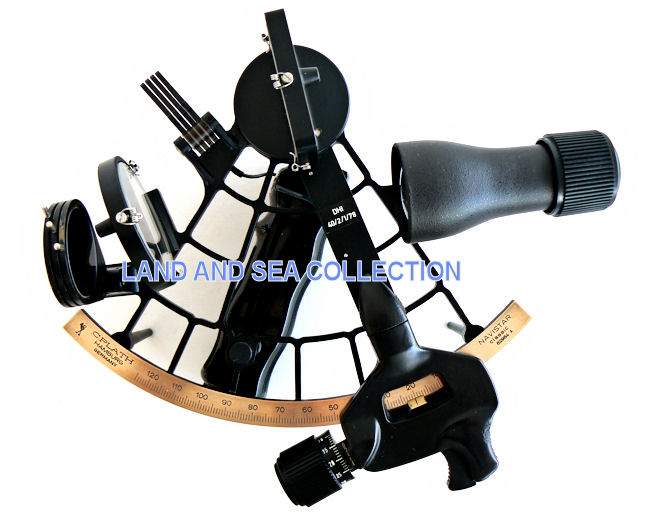
We sold our last C. Plath Navistar Classic sextant last Christmas and have just replaced it with another in like new condition. These instruments were made in limited
quantities, are rare, hard to find, and very much in demand by discriminating collectors and maritime industry professionals
who still practice the art of celestial navigation.
But this time we have our first Navistar that is equipped
with both a 4 x 40 star scope likely made by Carl Zeiss, and a Beck Kassel 6 x 30 sun scope which makes it even more
desirable.
Professional navigators understand the advantage of the higher powered
scope for shooting early rising planets and getting more accurate sun sights for pin point precision
There are no papers with this instrument, but we have tested it thoroughly and
can guarantee it is in perfect condition with ZERO index error. Based on our proprietary register of C. Plath instruments
we can also date it by its serial number, 62964, as being made in 1982.

Like new index mirror
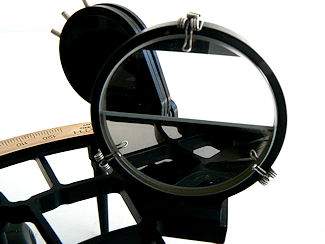
Perfect horizon mirror
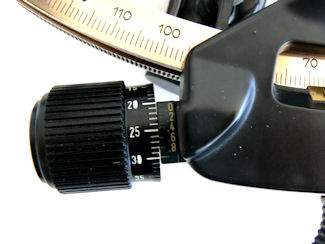
Special micrometer & vernier

Navistar imprint & serial number
It has a Mahogany wood case with energy absorbing green liner. The sextant sits in the case
with its handle up, ready for use, a handy feature. On its index arm is the Deutche Hydrographic Institute seal of approval.
The Deutche Hydrographic Institute stamp
of approval elevates it to the highest level because it indicates this instrument was tested by DHI, and
found to meet the more stringent standards for commercial use. Hence, this sextant sold for more originally then the regular
Navistar Classic.
The Navistar Classic was the top of the
Plath line and was made in limited quantities, and was made with a guaranteed non-adjustable instrument error of 10 arc seconds
or less. It sold for a premium over all its other sextants. For example, almost 30 years ago, they sold for over $1000.00,
and as recently as 2001, the price had risen to $4000.00.
Don’t confuse this model
with the similarly named “Navistar Professional“ which. in our opinion is the worst sextant made
by Plath or the “Navistar Traditional“ which was made shortly before sextant production ended. That
instrument has an error up to 20 arc seconds.
You can identify the “Navistar Classic”
by these clues:
1. It has a special micrometer drum
2. The Navistar brand imprint on the arc.
3. The vernier has six
indents and reads to 10 seconds of arc.
4. Comes with a fine wood case with
a green absorbent liner,
5. And an instruction booklet, and Plath’s certification with matching
numbers.
Some have a label from the Deutche Hydrographic Institute dated 2/1/78 certifying them for commercial
service. All these features are present with this instrument except the instruction booklet and certificate.
PROVENANCE: This instrument was formerly the property of a steam
ship line as part of one of their ship’s navigation suite, but has always been carefully cared for.
For the seven year period from
1978 through 1985 only 1693 Navistar Classics were made. That is only 211 per year to satisfy worldwide demand.
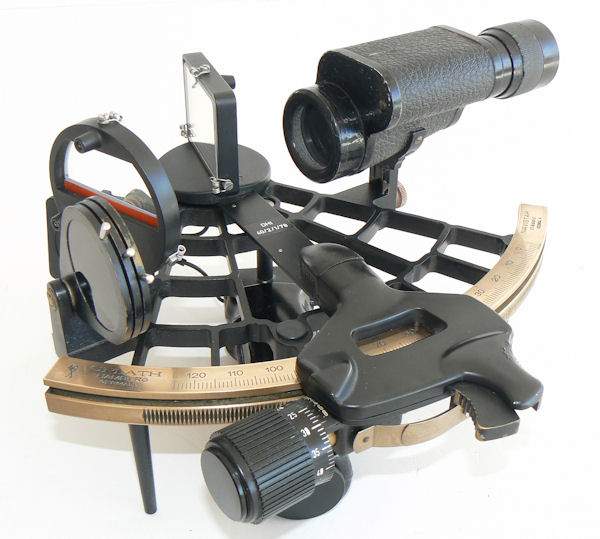
CONDITION: The split
image horizon mirror and the index mirror both are in “new condition“. The stainless and chrome fittings
are all bright and shiny. There is little evidence of use except that the 6 x 30 scope has some minor paint loss as does
the trigger. The paint on the frame is excellent with no evidence of lifting. It operates like a well
oiled piece of machinery, and has no mechanical faults except: The case has a some scuff marks,
and scratches on its top. The lighting does NOT work after a number of bulbs and batteries have been tried. This
is true of most C. Plath sextants, and a working light would be the exception. There is no manual or certificate
of inspection. The certificate of inspection is no longer of significance since the instrument was made to a level of
accuracy that manufacturing error can be ignored. There is no index or side error which is a good thing.
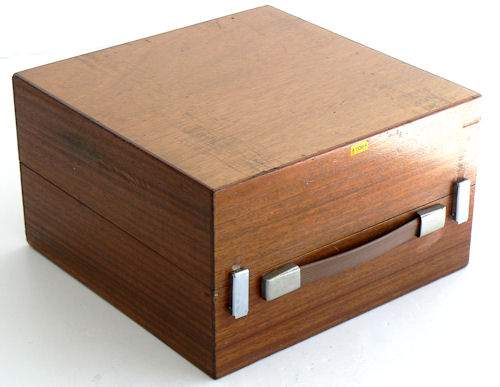
Sturdy Mahogany case
This C.
Plath Navistar Classic requires someone who can appreciate the fine points of a sextant, and is willing to pay an
appropriate price for this level of quality and excellence. It is suitable for a collector or for use at sea
.
STAR RATING: This fine Collector Quality instrument
rates 5 (- ) STARS only because of the lighting. Otherwise, its a 5.
QUALIFICATIONS: We are one of the few company’s still selling
navigation instruments that know anything about them. For purposes of judging whether Joel’s opinion counts, he
was the editor of the chapter on sextants of the 1977 Edition of “Bowditch”, The American Practical Navigator, NAVPUB 9; a
member of the U.S. Naval Academy Navigation Symposium Board, 1975 -1978; the author of a book on marine sextants, Cornell
Maritime Press,1975, and the founding president of Nautech Maritime Corporation which partnered with Tamaya of Japan in the
introduction of the MS 733 Spica, the MS 833, Jupiter, MS 933 Venus sextants and the famous NC-2 navigation computer, in the
U.S. market. Joel is a retired Master Mariner, and held a U.S. Navy “D” Qualification as a Senior Skipper – Oceans.
For six years he was a Varsity Offshore Sailing Team Coach at the U.S. Naval Academy.
Some of his memberships include the: Association of Naval Aviation, Silver Wings,
The Tailhook Association, Naval Academy Sailing Squadron, McCampbell’s Aces Squadron, Naval Historical Foundation, and
the Naval Order of the United States.
COMPANY HISTORY: In brief, Carl Plath started manufacturing
sextants, in addition to other nautical products, in Hamburg Germany in 1862 though the company’s origin dates back to 1837.
As a result WW II, C.Plath was dismantled completely by the occupation forces. Around 1950, various prohibitions
were lifted, and C. Plath was allowed to begin production again of sextants and other nautical instruments. Also in 1949,C.Plath
was offered a gyrocompass patent and in 1951 the first gyrocompass designed to this patent was presented to the public. C.Plath progressed
from the role of instrument maker to that of a modern marine navigation equipment manufacturer. In the following years the
product range was expanded by many more modern designs such as autopilots, speed logs, radio direction finders, etc.
In 1962 C.Plath was acquired by Litton Industries,
a large American concern.The C.Plath North American Division was set up in 1978 in College Park near Washington. 1996
saw the introduction of the world’s first fiber-optic solid-state gyrocompass by C.Plath. The first ever gyrocompass with
no moving parts. Sperry Marine was formed in 1997 with the combination of C.Plath, Decca Marine and Sperry Marine with more
organizational changes yet to come. After 163 years, C.Plath changes its name to Sperry Marine in May 2000. In 2001 Sperry
Marine becomes part of the Northrop Grumman Corporation. Directly thereafter, C. Plath quit producing
sextants. The parent company has completely liquidated everything including machinery, equipment and spare parts.
C. PLATH NAVISTAR CLASSIC SPECIFICATIONS:
Measuring Range: -5 to 125 degrees
Telescope: 4 x 40 Coated
optics
Frame: Bronze with black enamel paint and bronze arc.
Micrometer Drum and Vernier Scale: reads
to 10 seconds of arc
Index Mirror: 56 x 42 mm. aluminized on the rear side.
Horizon Mirror: 57mm diameter.
Shades:
4
for index mirror
3 for horizon mirror
Weight sextant: 4.2 lbs, Weight case 6 lbs.
INCLUDED ARE:
1 C. Plath Sextant frame
1 4 x 40 star scope
1 6 x 30 sun scope
1 Mirror adjustment tool
1 Varnished Mahogany sextant case
